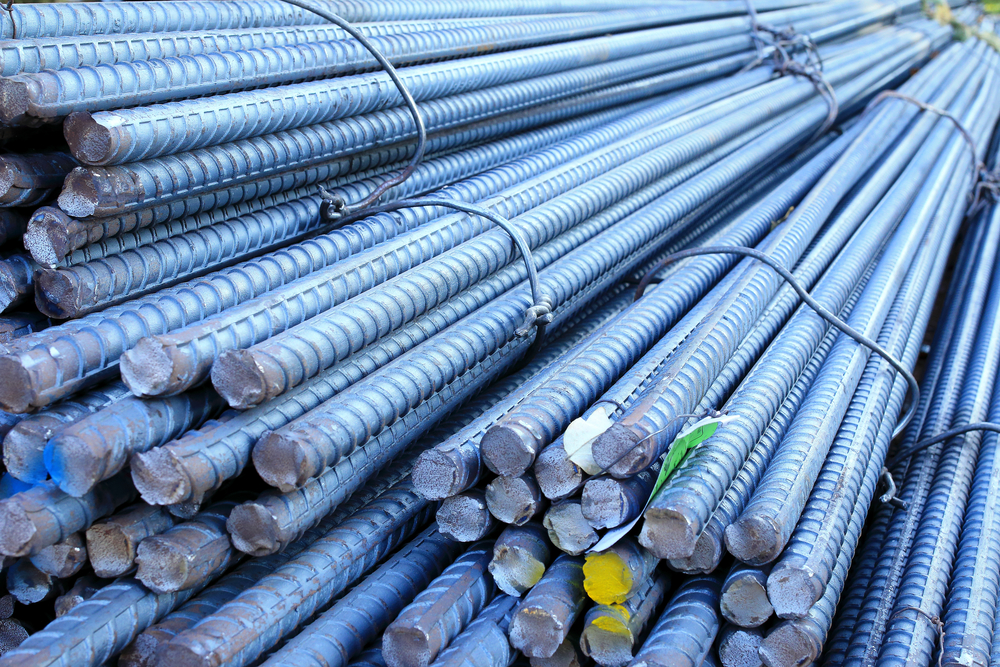Sustainability has long been a pressing issue on the minds of many socially conscious consumers and business owners alike, and for good reason – the planet’s ecosystem depends on it. For vital industries like construction and manufacturing, the need to recognize and act upon the vast importance of sustainability is not only a sensible business decision but also a duty to the natural world.
Sustainability has long been a pressing issue on the minds of many socially conscious consumers and business owners alike, and for good reason – the planet’s ecosystem depends on it.
For vital industries like construction and manufacturing, the need to recognize and act upon the vast importance of sustainability is not only a sensible business decision but also a duty to the natural world.
The circular economy is an effective process adopted by many in an effort to improve overall sustainability, and for immensely popular and critically important materials like steel, it may even be a necessity in maximizing resources and minimizing carbon footprints.
How exactly does this make a difference in terms of the future of sustainable production, and why should you be concerned? Whether or not you happen to be in the industry yourself, it is important to understand what exactly is being done to reduce the negative impact of manufacturing and construction on the environment, as you too could be a part of the solution. After all, sustainability is a subject that affects everyone.
Why is Sustainability Important?
According to the United Nations, climate change is the greatest threat that humanity has ever faced. Averting this crisis will no doubt require everyone to take action in some capacity. It starts by raising awareness and realizing the catastrophic consequences that await humankind if meaningful changes are not made.
What does this have to do with the manufacturing and construction industries? A great deal indeed. In fact, the construction industry is by far the biggest consumer of natural resources on the planet. Some reports show that around 75% of all natural resource use has been put into construction in years gone by, a worrying figure when you think about the finite nature of natural materials and the sheer level of global consumption.
Perhaps even more alarming is a recent article from the OECD (Organization for Economic Development and Co-Operation), which predicts that by 2060, the number of natural resources consumed by the construction industry around the world will double.
Huge changes must be made to ensure the safety and longevity of global humanity, and it comes with a host of unique business benefits, too, a persuasive and potentially lucrative point for vigilant entrepreneurs everywhere.
In order to do this, the right materials must be adopted, but so too must the methods in which they are worked on.
Sustainability in the Manufacturing Industry
A move toward sustainable manufacturing practices is quickly becoming a mainstay of countless businesses, and it can’t come soon enough. As it stands, around one-quarter of the energy in the U.S. is taken up by manufacturing processes alone.
Those that are able to implement and hit their sustainability goals can relish in the many additional benefits it brings, such as easier brand building, better employee retention rates, and possibly even greater product value.
The latter being so prevalent, in fact, that 66% of customers are more willing to spend more on products they know have been sustainably produced.
Perhaps one of the best and potentially most straightforward methods of increasingly sustainability techniques is for businesses to commit to reducing wastage. Proper inventory control is a great way to do this, as is recycling in general.
As usual, technology has a large role to play in the progression of industries, and manufacturing is no different. From advanced 3D printers to a range of digital tools, the race for more sustainable manufacturing can and should be aided by the latest and greatest technological developments.
There are many wonderful software options available to businesses nowadays, each of them offering up a wealth of unique benefits. Companies using a dependable integrated software solution to help them tackle their waste management and process optimization are likely going to have an easier time reaching their sustainability goals than those who don’t choose the more modern approach.
Sustainability in the Construction Industry
By its very nature, the construction industry is responsible for taking a toll on the earth’s resources. There’s a great deal riding on the construction industry in terms of their ability to promote and practice sustainability.
For example, an article from the World Green Building Council states that the global green building industry has the potential to cut energy consumption by 50% or more by 2050.
Sustainable building practices are not only good for the environment, but they often tend to save both companies and consumers a huge amount of money, too, particularly when firms opt to utilize recycled materials.
As the world’s population continues to grow and finite natural resources start to dwindle, circumstances demand that current construction practices consistently evolve. Averting disaster by changing the current trajectory is doable, provided companies recognize their responsibility and play their part.
The Importance of Circular Principles
What is the circular economy?
Is it time you adopted a circular approach in your own manufacturing efforts? Maybe you already do it to some degree, but it’s certainly worth finding out a bit more about what it can offer you.
While there are plenty of different definitions of what a circular economy is, in this case, it is a framework of production that essentially serves to guarantee sustainable consumption over time.
Traditionally, as raw materials are worked, they tend to lose much of their value, be it their resale value or the integrity of their physical properties. A circular economy seeks to combat this eventuality and maximize its lifecycle, allowing for the greatest possible rates of sustainable production.
This tends to be done by adopting a no-waste policy, a system that involves developing more durable products to begin with, while streamlining the ease by which they can be reused and recycled over time.
This might come as a stark contrast to the linear approach, a system that relies on the constant supply of natural raw materials to the detriment of the environment. Acquiring these materials and later disposing of them at the consumer’s end is ecologically and economically taxing, hardly a sustainable option.
Unfortunately, a report from you matter.world states that only 9% of the world is circular today. Adopting a circular economy can be difficult for a wide array of complex reasons, which is why observable market incentives can be so crucial.
When it comes to adopting a set of circular economy principles, it is worth taking a look at a few fundamentals, such as:
- Recyclability
- Reusability
- Waste reduction
- Pollution minimization
To meet these basic principles, production processes must be optimized to cater to the materials at hand. It is worth noting that steel is in many ways the ideal metal for manufacturing in a circular economy, due in part to the ease by which it can be reused and reworked.
Benefits
One of the main benefits a circular economy can provide is the reduction of environmental pressure caused by the impact of manufacturing, but there are countless bonuses the system might be able to provide businesses of all different shapes and sizes.
A well-structured and dependable circular system may prove to be a superb way of strengthening your supply chain, all while you reduce the need for a constant influx of new natural materials, which is environmentally strenuous and often an unreliable process.
For anyone who wants to cut inventory costs, reduce their carbon emissions, meet sustainability quotas, and generally contribute toward reducing the world’s greenhouse gas production, this could be the best way forward.
The World Resources Institute claims that through the right circular strategies, greenhouse gas emissions can be cut by 39%, which is a monstrous 22.8 billion tons!
Plus, the adoption of a circular process could end up creating many more jobs, particularly when compared to the linear counterpart. For example, say you wanted to primarily work with steel – the circular system could enable you to both directly and indirectly create jobs for salvagers, recyclers, scrap metal workers, and countless others.
This could take time, of course, but the opportunities are certainly there once you start to think about them.
Examples within manufacturing and construction
The lasting, impactful, and innovative ways in which manufacturing and construction companies are opting for sustainability are, in many ways, changing the shape of the modern business.
IKEA is committed to sustainability, and in 2021, they launched a initiative to help them secure sustainable energy at the supplier’s end in an effort to reach 100% renewable energy throughout their entire chain by 2030.
A prime example of a construction company striving for sustainability and process optimization is Honeywell, which have been using a digital approach to their building management efforts.
The sustainable building giants Holcim to reducing its cement usage by 33%, its ready-mix concrete by 15%, and its aggregates by 20%. By continuing to pilot a nature-first approach to construction, some organizations are paving the way for others, setting an example and highlighting which changes need to be made before it becomes too late.
Admittedly, not everyone is in the position of being able to suddenly alter their current processes to fit a more sustainable agenda, be it a result of monetary constraints, a lack of workforce availability, or market pressure.
It is worth noting that there are plenty of options out there once you start looking, whether that’s in the form of government support or tax incentives. There are methods of making the transition to a sustainable operation, even if it starts by taking the smallest of steps.
The Lifecycle of Steel
Despite the significant evolution of highly advanced steel-making processes over the years, modern development techniques are still based on Henry Bessemer’s process, first practiced back in 1856.
There are two main ways to produce steel in the modern world, and they account for almost all steel that’s around today.
EAF (electronic arc furnace) production is a production method that repurposes scrap steel, thus reducing the need for raw material and therefore reducing overall environmental impact. Plus, it’s still highly durable.
On the other hand, BOS steel, or virgin steel, utilizes mainly raw materials and is responsible for the creation of around 70% of the world’s steel.
EAF production consists of heating up steel scrap (or pig iron) with electronic arcs in a furnace, which in turn creates molten steel. Lime is added to the molten mix to remove the oxides, and after the slag (waste matter) is removed, the mixture is ready for secondary steel-making.
BOS is a similar process in that it also involves heating up materials in a furnace, but it uses the raw pig iron as its base material. It also utilizes coal throughout the process, creating damaging carbon monoxide at the same time, although both methods have a unique set of pros and cons.
Steel’s Circular Economy Credentials
In terms of a circular economy, steel has some impressive credentials, to say the least. Alongside being infinitely recyclable, a compelling enough trait as it is, it’s immensely versatile and strong.
From buildings and societal infrastructures to knives and forks, steel is found everywhere you look, partly because it lasts for so long.
Once you break the circle of production down into its basic stages, it tends to consist of:
- Raw material acquisition
- Production
- Distribution
- Consumption
- Disposal and Recycling
Thankfully, steel is a material that has the potential to excel at every stage of the process, making it an ideal candidate for a circular economy material.
In fact, steel is so good at retaining its properties despite being recycled over and over again that it has a global recycling rate of 83%, but this figure goes as high as 90% in some countries, according to Reuters Events.
This means that, in theory, the need for virgin steel and the raw materials used to create it in manufacturing can be drastically reduced, resulting in a net decline of harmful production emissions like carbon monoxide.
The Future of Using Steel Sustainably
For a circular economy model to be successful, everyone needs to be aware of its benefits and commit to operating as part of a network.
A socially conscious, environmentally friendly group of interlocking industries working collaborating together can make the most out of the processes and materials at hand.
Essentials of a successful circular economy
From the steelmakers and recyclers to the architects and researchers, cross-industry cooperation will likely be the key to success.
Public awareness can also be a big factor when it comes to establishing a circular economy. For instance, if people are more inclined to recycle their products and cut down on wastage, resources tend to be able to last longer.
This behavioral change can be extremely difficult, particularly on a societal level, but thankfully, a recent study has shown that 85% of consumers have indeed become greener over the last few years.
The system will succeed when every aspect of its cycle is optimized and accounted for. This infrastructural change starts from the ground up and encompasses every part of the production process.
In construction, this means sourcing the right materials and implementing the most sustainable tools and building techniques (among a host of other undertakings).
The importance of designing for deconstruction and reuse
Recycling is, of course, the preferred alternative to simply disposing of buildings and products in landfills, but in many cases, the process itself still takes a great deal of energy to pull off.
In this regard, those who instead design their products for deconstruction may make much greater long-term savings than those who do not.
This not only aids the construction and manufacturing industries in the effectiveness of their resource management endeavors, but it generally aids the establishment of a circular economy model.
Designing for deconstruction boils down to material choice, construction methods, resource availability, and information, i.e., whether or not contractors are aware of how to deconstruct buildings or not in the first place.
Steel is a superb material to elect for this method of design, as it can be developed in so many different grades with various purpose-built properties. Steel is intrinsically more reusable in this regard, making it a popular choice when designing for deconstruction and reuse.
What’s Next?
Among supply chain disruption and a host of various world events, the price of steel remains locked at a high premium.
Perhaps a move toward a circular system is a good way to reduce prices, maximize finite resources and ultimately, bolster worldwide sustainability rates.
It’s not just the responsibility of the manufacturers and the construction companies to figure this out either. It requires the input of the consumer and governmental support to get it right.
The conditions can be met, and if corporate responsibility and environmental awareness continue to rise, so too can sustainability rates.
Technological innovation will likely have a critical role to play in the future of both manufacturing and construction, and steel, the wonder metal, probably won’t be going anywhere.








